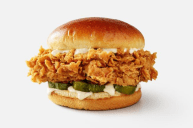Subway is a classic choice for a quick, healthy-ish sandwich when you're on the go. Even without the beloved five-dollar-footlong deal, Subway sandwiches are cheap, easy, and you know what you're getting for your money. However, recent tests done on the Subway tuna sandwich show that this seafood classic may not be what we think it is.
Lawsuit Over a Tuna Sandwich
The foot-long tuna sandwich is an ideal option for pescatarians who visit the chain. However, this past weekend, The New York Times came out with a report showing that lab tests found no tuna DNA in Subway's tuna sandwich, which begs the question: What does the sandwich contain?
It all started earlier this year, when a lawsuit was issued in the U.S. District Court for the Northern District of California alleging that the fast food chain's tuna sub consisted of "a mixture of various concoctions that do not constitute tuna." The lawsuit says that Subway imitates the fishy appearance of tuna by blending together other unknown ingredients, rather than using real tuna.
The two plaintiffs in the complaint are Karen Dhanowa and Nilima Amin, both residents of the Bay Area. Their attorneys aim to get the claim changed to a class action lawsuit in order to open up the case to the many Subway customers in California who purchased tuna sandwiches.
"Not Tuna and Not Fish"
NYT submitted for lab analysis "60 inches worth of Subway tuna sandwiches" from three different Subway locations in Los Angeles. The results of the lab tests found no identifiable tuna, and even more disturbingly, the lab couldn't identify what type of fish or other ingredients were in the concoction. "No amplifiable tuna DNA was present in the sample and so we obtained no amplification products from the DNA. Therefore, we cannot identify the species."
The attorneys declined to say what the ingredients found by the lab tests were, but in an email to The Washington Post said that "we found that the ingredients were not tuna and not fish."
What Does It All Mean?
However, Inside Edition also conducted a test at a commercial food testing lab earlier this year using three Subways in New York City, finding that these samples did indeed contain tuna.
A lab spokesperson explained that there are few potential conclusions. Regarding the fish testing samples that were shown to contain no tuna, the spokesperson says "There's two conclusions. One, it's so heavily processed that whatever we could pull out, we couldn't make an identification. Or we got some and there's just nothing there that's tuna."
An employee of the sandwich chain tried to defend Subway by showing the labeling of a package that reads "Flaked White Tuna in Brine." In addition, the nutritional information listed on Subway's website says that the tuna salad in the sandwiches contains flaked tuna in brine, mayonnaise, and an additive to protect the flavor. A Subway spokeswoman confirmed that this is up to date.
Seafood experts have concluded that the issue may go back further than Subway. "I don't think a sandwich place would intentionally mislabel," said Dave Rudie, president of Catalina Offshore Products. "They're buying a can of tuna that says 'tuna.' If there's any fraud in this case, it happened at the cannery."
Subway's Take on the Matter

"The taste and quality of our tuna make it one of Subway's most popular products and these baseless accusations threaten to damage our franchisees, small business owners who work tirelessly to uphold the high standards that Subway sets for all of its products, including its tuna," a Subway representative said.
"Given the facts, the lawsuit constitutes a reckless and improper attack on Subway's brand and goodwill, and on the livelihood of its California franchisees. Indeed, there is no basis in law or fact for the plaintiffs' claims, which are frivolous and are being pursued without adequate investigation."




